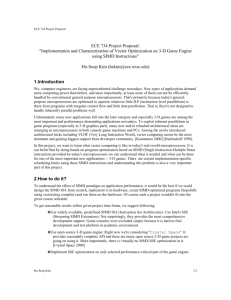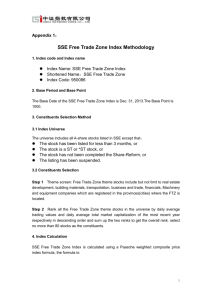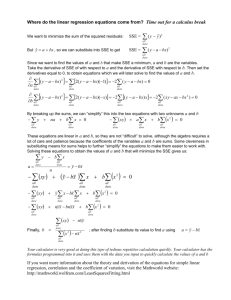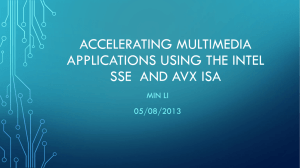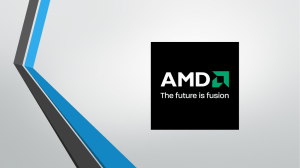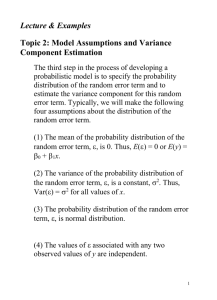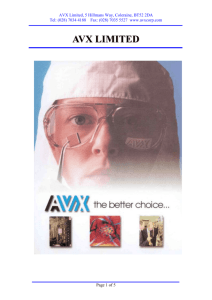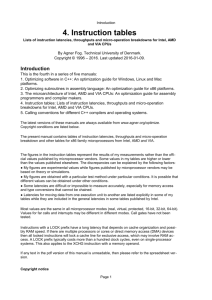Google_Summer_of_Code_2013_Project_Proposal
advertisement
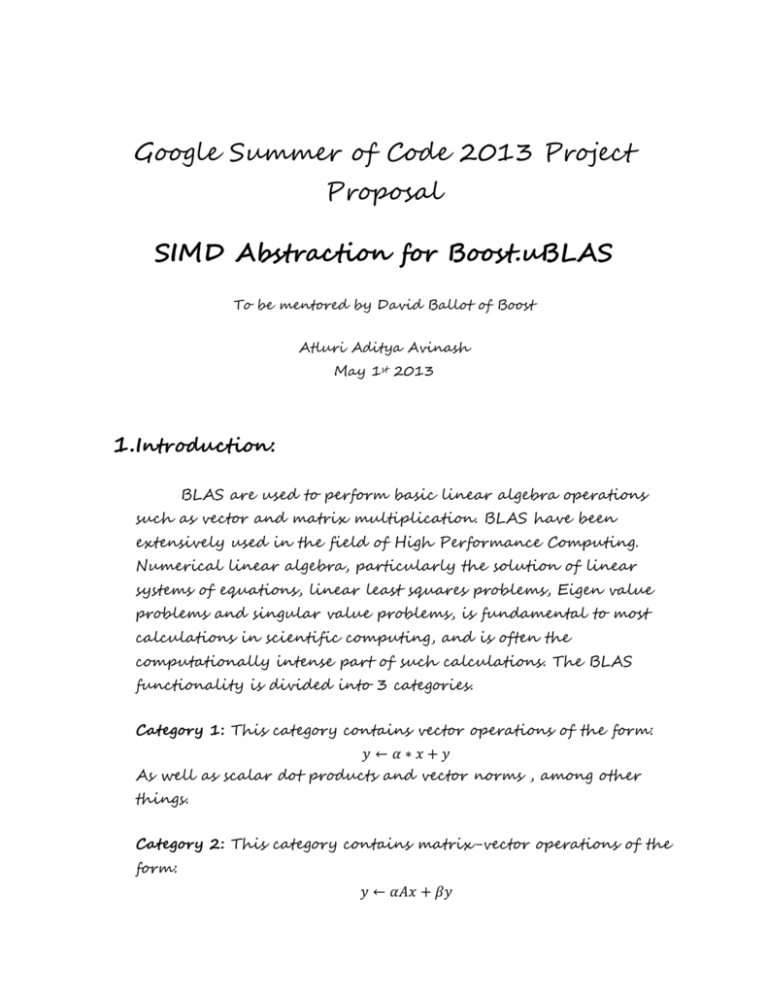
Google Summer of Code 2013 Project
Proposal
SIMD Abstraction for Boost.uBLAS
To be mentored by David Ballot of Boost
Atluri Aditya Avinash
May 1st 2013
1.Introduction:
BLAS are used to perform basic linear algebra operations
such as vector and matrix multiplication. BLAS have been
extensively used in the field of High Performance Computing.
Numerical linear algebra, particularly the solution of linear
systems of equations, linear least squares problems, Eigen value
problems and singular value problems, is fundamental to most
calculations in scientific computing, and is often the
computationally intense part of such calculations. The BLAS
functionality is divided into 3 categories.
Category 1: This category contains vector operations of the form:
𝑦 ←𝛼∗𝑥+𝑦
As well as scalar dot products and vector norms , among other
things.
Category 2: This category contains matrix-vector operations of the
form:
𝑦 ← 𝛼𝐴𝑥 + 𝛽𝑦
As well as solving 𝑇𝑥 = 𝑦 for 𝑥 with 𝑇 being triangular, among
other things.
Category 3: This category contains matrix-matrix operations of
the form:
As well as solving 𝐵 ← 𝛼𝑇
−1
𝐶 ← 𝛼𝐴𝐵 + 𝛽𝐶
𝐵for triangular matrices𝑇, among other
things. This level contains the widely used General Matrix
Multiply operation.
Designers of computer programs involving linear algebraic
operations have frequently chosen to implement low level
operations, such as dot product or the matrix vector product, as
separate subprograms. This may be observed both in many
published codes and in codes written for specific applications.
2.Existing Solutions:
a. ATLAS:
Automatically Tuned Linear Algebra Software
(ATLAS) is software library for linear algebra. It provides a
mature open source implementation of
BLAS APIs for C and Fortran77. ATLAS is often recommended
as a way to automatically generate an optimized BLAS library.
While its performance often trails that of specialized libraries
written for one specific hardware platform, it is often the first
or even only optimized BLAS implementation available on
new systems and is a large improvement over the generic BLAS
available at Netlib. For this reason, ATLAS is sometimes used
as a performance baseline for comparison with other products.
ATLAS has good SIMD support.
b. Intel MKL:
The Intel Math Kernel Library, supporting the old Intel
Pentium (although there are some doubts about future support
to the Pentium architecture), Core and Itanium CPUs
under Linux, Windows and Mac OS X.
c. cuBLAS:
Optimized BLAS for NVIDIA based GPU cards. The NVIDIA
CUDA Basic Linear Algebra Subroutines (cuBLAS) library is a
GPU-accelerated version of the complete standard BLAS
library that delivers 6x to 17x faster performance than the
latest MKL BLAS. Building on the GPU-accelerated BLAS
routines in the cuBLAS library, heterogeneous LAPACK
implementations such as CULA Tools and MAGMA are also
available.
3.Goals of SIMD Abstraction of Boost.uBLAS:
Our aim with SIMD (Single Instruction Multiple Data)
Abstraction is to create a fast, modern, well designed BLAS
library that can run on Intel, AMD and ARM processors and can
use their native parallelism. In computing, Streaming SIMD
Extensions (SSE) is an SIMD instruction set extension to
the x86 architecture. SSE contains 70 new instructions, most of
which work on single precision floating point data. SSE
originally added eight new 128-bit registers known as XMM0
through XMM7. SIMD instructions can greatly increase
performance when exactly the same operations are to be
performed on multiple data objects. Typical applications
are digital signal processing and graphics processing. SSE was
subsequently expanded by Intel to SSE2, SSE3, SSSE3, and SSE4.
The processors contain inbuilt hardware that can operate on
128-bit data (256 for AVX).
For AMD Processors:
Initially, the SIMD abstraction for AMD processors will be
developed on AMD K10 (supports 3DNow!, SSE, SSE2, SSE3,
SSE4a) and Bulldozer Architectures (supports 3DNow!, SSE, SSE2,
SSE3, SSE4.1, SSE4.2, CULMUL, AVX).
For Intel Processors:
The SIMD abstraction for Intel processors will be developed
on Core 2 Duo [aka Penryn] (supports upto 4.1, AVX) and same
generation architectures. Later extended to Nehalem and current
generation architectures (supports upto SSE 4.2, AVX).
Examples of SIMD Abstraction:
SSE: The below code shows the basic matrix addition using SSE
deployed on Intel processors.
int lcount = loopCount;
int iBufferHeight = MAT_HEIGHT;
for (int i =
float*
float*
float*
0; i < lcount; i++){
pImage1 = InputBuffer1;
pImage2 = InputBuffer2;
pOutImage = OutputBuffer;
for(int iY = 0; iY < iBufferHeight; iY++){
__m128 Xmm_A = _mm_load_ps(pImage1);
__m128 Xmm_B = _mm_load_ps(pImage2);
__m128 Xmm_C = _mm_add_ps (Xmm_A, Xmm_B);
_mm_store_ps(pOutImage, Xmm_C);
pOutImage+=4;
pImage1+=4;
pImage2+=4;
}
}
AVX: The below code shows the basic matrix addition using AVX
deployed on Intel Processors.
int lcount = loopCount;
int iBufferHeight = MAT_HEIGHT;
for (int i = 0; i < lcount; i++)
{
float* pImage1 = InputBuffer1;
float* pImage2 = InputBuffer2;
float* pOutImage = OutputBuffer;
for(int iY = 0; iY < iBufferHeight; iY+= 2)
{
__m256 Ymm_A = _mm256_load_ps(pImage1);
__m256 Ymm_B = _mm256_load_ps(pImage2);
__m256 Ymm_C = _mm256_add_ps (Ymm_A, Ymm_B);
_mm256_store_ps(pOutImage, Ymm_C);
pOutImage+=8;
pImage1+=8;
pImage2+=8;
}
}
4.Current State of Development:
Currently. Boost.uBLAS do have a good SIMD extensions on CUDA
and OpenCL which have a greater performance through put for
massively parallel data sets and algorithms. But, uBLAS doesn’t
have good SIMD extensions on Intel, AMD CPUs. These extensions
can handle small data sets where there is a significant
requirement of parallel and serial implementation.
5.Goals of GSOC Project:
The following are the goals of the GSOC project during the
development of SIMD extensions (abstraction) for Boost.uBLAS.
1. Checking the uBLAS library and find the areas where
there can be significant improvements in performance of
the algorithms.
2. Designing algorithms appropriately so that it can be
implemented on SSE and AVX.
3. Development of backend using SSE and AVX on current
generation architectures.
4. Development of frontend for the SIMD abstraction using
Object Oriented Programming concepts in C++.
5. Checking for errors and Error Handling of the frontend
and backend.
6. Extending the backend to SSE2, SSE3, SSE4.1, SSE4.2
using their newly added instruction sets.
7. Adding the feature of CULMUL to AMD processors.
8. Development of frontend for added SSEx backend to
exploit their features.
9. Testing of the library on different Intel and AMD
architectures.
10.
Development of uBLAS on ARM Neon.
The point 10 is too concise. Its description is, development of uBLAS on
ARM Neon which goes through the same process as in development of
SIMD abstraction on Intel and AMD CPUs.
6.Schedule:
1st Month: Points 1 to 4.
2nd Month:
Points 4 to 7.
3rd Month: Points 8 to 10.
7.Background Information:
7.1 Personal Details:
Name: Atluri Aditya Avinash
University: Indian School of Mines, Dhanbad
Major: Electrical Engineering
Degree Program: Bachelor of Technology
Email: adityaavinash143@gmail.com
Availability: 3-4 days a week + occasional weekends; starting
from June to September. Will work when there is a top priority
situation to deal with.
7.2 Educational Background:
My major in college is Electrical Engineering. I have did a
project for power generation firm Reliance Power Limited during
summer of 2011 on MATLAB. I have coded the algorithms in my
courses and improved them using programming concepts. I have
secured 100% in both maths and science in my school. I passed
out of my high school with aggregate of 90% having scored 95%+
in both science and math.
7.3 Programming Background:
I program in C/C++, Python, GO, shell, MATLAB. I have
experience in using OpenMP, Intel AVX and SSE, CUDA, OpenCL,
Boost libraries. I have been programming since 2005. My first
code is in html for online exams. I have experience in using
Windows and Ubuntu(extensively). I am one of the Kernel
Developer for Ubuntu. I have submitted few bug fixes and patches
for Ubuntu but, the same patches were submitted by other
developers. I have presented a paper at a national conference. The
paper is related to the field of bio-informatics where an
algorithm is accelerated using CUDA. I have worked on software
projects with my friends. I have developed most the algorithms in
Electrical Engineering to CUDA. “Think Parallel!!”, this is what I
am good at. I write CUDA code for fun, knowing all the
boundaries of performance bottlenecks. I participate in coding
social networking sites like stackoverflow, some communities on
#IRC and github.com.
7.4 Self Assessment:
C++: 4
C++ STL: 3
Boost Libraries: 3
Familiar with odeint and uBLAS.
SSE and AVX: 3
Linear Algebra: 4
